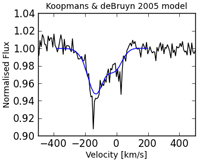ASKAP produces first spectral line 'data cube'10 April 2014 The ASKAP team has this week produced the first BETA spectral line image using six ASKAP antennas installed with innovative phased array feed (PAF) receiver systems, as part of ongoing commissioning tests at the Murchison Radio-astronomy Observatory (MRO) in Western Australia. With the recently reconfigured hardware correlator and the six-antenna test array known as the Boolardy Engineering Test Array (BETA), an observation was made with up to six hours of data collected and analysed to create the first spectral line image, and data cube, with the ASKAP system. The chosen target was the strong gravitational lens system PKS1830-211, used in previous commissioning tests with the ASKAP system because of the strong HI absorption feature at a redshift of z=0.88, or 753 MHz. This feature also makes the source an ideal target for BETA, which is one of just a few telescopes capable of such an observation at this frequency. The resulting image is the first to incorporate all 15 baselines from the BETA system, and also the first to be made with the array's full spectral resolution of 18 kHz. While still quite preliminary, the accompanying spectrum is of particular interest to the team. Close comparison with spectra previously taken with the Westerbork radio telescope at a similar resolution has shown a second feature which appears more pronounced in the new BETA spectrum than previously seen, indicating an interesting opportunity for scientific follow up. This milestone is quite significant for the ASKAP project – particularly in terms of the technical implications of demonstrating the success of the design of the system. The commissioning team is now working to further analysis of the collected data, and has made the spectral line image cube data publicly available for download. Read more in the latest ASKAP Commissioning Update. Back to Latest ASKAP News page. |
This loads a font easier to read for people with dyslexia.
This renders the document in high contrast mode.
This renders the document as white on black
This can help those with trouble processing rapid screen movements.

